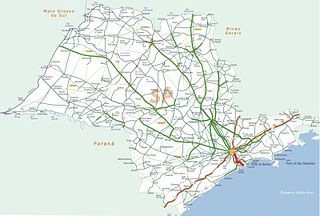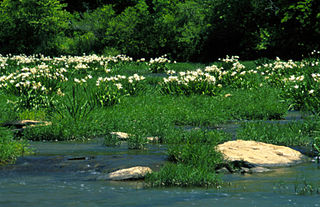A bitstream, also known as binary sequence, is a sequence of bits.
10BROAD36 is an obsolete computer network standard in the Ethernet family. It was developed during the 1980s and specified in IEEE 802.3b-1985.
In computing, a persistent data structure or not ephemeral data structure is a data structure that always preserves the previous version of itself when it is modified. Such data structures are effectively immutable, as their operations do not (visibly) update the structure in-place, but instead always yield a new updated structure. The term was introduced in Driscoll, Sarnak, Sleator, and Tarjans' 1986 article.

The Flint River is a 344-mile-long (554 km) river in the U.S. state of Georgia. The river drains 8,460 square miles (21,900 km2) of western Georgia, flowing south from the upper Piedmont region south of Atlanta to the wetlands of the Gulf Coastal Plain in the southwestern corner of the state. Along with the Apalachicola and the Chattahoochee rivers, it forms part of the ACF basin. In its upper course through the red hills of the Piedmont, it is considered especially scenic, flowing unimpeded for over 200 miles (320 km). Historically, it was also called the Thronateeska River.

A ring network is a network topology in which each node connects to exactly two other nodes, forming a single continuous pathway for signals through each node – a ring. Data travels from node to node, with each node along the way handling every packet.

Rodovia Anchieta is a highway connection between São Paulo and the Atlantic coast, the cities of Cubatão and Santos, in Brazil. In the plateau, the highway serves several cities of Greater São Paulo, such as São Bernardo do Campo, São Caetano do Sul, Santo André and Riacho Grande and traverses a picturesque region of dams and rain forests.

Rodovia dos Imigrantes is a highway in the state of São Paulo, Brazil. The highway connects the city of São Paulo to the Atlantic coast and with the seaside cities of São Vicente and Praia Grande. It follows the route of Rodovia Anchieta and is also one of Brazil's busiest highways, especially on weekends.

Landsford Canal State Park is a South Carolina state park in Chester County, two miles (3.2 km) from US 21. The 448-acre (1.81 km2) park contains the ruins of the Landsford Canal built using slave labor to bypass rapids on the Catawba River between 1820 and 1825. The coming of the railroad caused the canal to be abandoned. The former lock keeper's house contains an interpretive museum. In addition to the canal, visitors also can see one of the largest remaining stands of Hymenocallis coronaria, the Shoals spider-lily, that grows in the shoals of the river and blooms from mid-May to mid-June. The park offers hiking, picnicking, boating, and fishing, as well as a playground.

The Cahaba River National Wildlife Refuge is a 3,689.63 acres (15 km2) National Wildlife Refuge located in central Alabama, along the Cahaba River downstream from Birmingham, Alabama. The refuge was established on September 25, 2002. Additional purchases were approved that will potentially increase the size of the refuge to 7,300 acres (29.5 km²). Additional negotiations propose an expansion to a potential 280,000 acres (1,100 km2), most of which currently belongs to private landowners. The facility is unstaffed, but is administered by the Mountain Longleaf National Wildlife Refuge in Anniston, Alabama.
State management refers to the management of the state of one or more user interface controls such as text fields, OK buttons, radio buttons, etc. in a graphical user interface. In this user interface programming technique, the state of one UI control depends on the state of other UI controls. For example, a state managed UI control such as a button will be in the enabled state when input fields have valid input values and the button will be in the disabled state when the input fields are empty or have invalid values. As applications grow, this can end up becoming one of the most complex problems in user interface development.

In geology, ripple marks are sedimentary structures and indicate agitation by water or wind.
A unidirectional network is a network appliance or device that allows data to travel in only one direction. Data diodes can be found most commonly in high security environments, such as defense, where they serve as connections between two or more networks of differing security classifications. Given the rise of industrial IoT and digitization, this technology can now be found at the industrial control level for such facilities as nuclear power plants, power generation and safety critical systems like railway networks.
In telecommunication, a Berger code is a unidirectional error detecting code, named after its inventor, J. M. Berger. Berger codes can detect all unidirectional errors. Unidirectional errors are errors that only flip ones into zeroes or only zeroes into ones, such as in asymmetric channels. The check bits of Berger codes are computed by counting all the zeroes in the information word, and expressing that number in natural binary. If the information word consists of bits, then the Berger code needs "check bits", giving a Berger code of length k+n. . Berger codes can detect any number of one-to-zero bit-flip errors, as long as no zero-to-one errors occurred in the same code word. Similarly, Berger codes can detect any number of zero-to-one bit-flip errors, as long as no one-to-zero bit-flip errors occur in the same code word. Berger codes cannot correct any error.

A bedform is a feature that develops at the interface of fluid and a moveable bed, the result of bed material being moved by fluid flow. Examples include ripples and dunes on the bed of a river. Bedforms are often preserved in the rock record as a result of being present in a depositional setting. Bedforms are often characteristic to the flow parameters, and may be used to infer flow depth and velocity, and therefore the Froude number.

Distributed data flow refers to a set of events in a distributed application or protocol.
BBC Redux is a BBC Research & Development system that digitally records television and radio output in the United Kingdom produced by the British Broadcasting Corporation. It has been operating since 2007 and contains several petabytes of recordings and subtitle data. It is notable for being the proof of concept for the Flash video streaming version of the BBC iPlayer.

React is a free and open-source front-end JavaScript library for building user interfaces or UI components. It is maintained by Facebook and a community of individual developers and companies. React can be used as a base in the development of single-page or mobile applications. However, React is only concerned with state management and rendering that state to the DOM, so creating React applications usually requires the use of additional libraries for routing, as well as certain client-side functionality.
Redux is an open-source JavaScript library for managing and centralizing application state. It is most commonly used with libraries such as React or Angular for building user interfaces. Similar to Facebook's Flux architecture, it was created by Dan Abramov and Andrew Clark.

Hyperboreae Undae is one of the largest and densest dune fields of Planum Boreum, the Martian North Pole. It is named after one of the classical albedo features on Mars. Its name was officially approved by IAU in 1988. It extends from latitude 77.12°N to 82.8°N and from longitude 302.92°E to 316.02°E. Its centre is at latitude 79.96°N, longitude 49.49°W, and has a diameter of 463.65 kilometres (288.10 mi).
VoTT is a free and open source electron app for image annotation and labeling developed by Microsoft. The software is written in the TypeScript programming language and used for building end to end object detection models from image and videos assets for computer vision algorithms.









